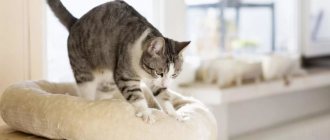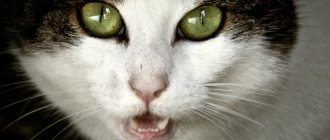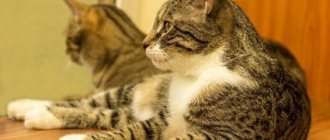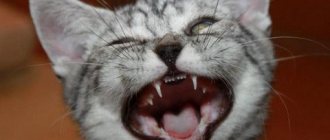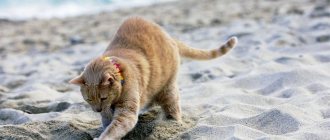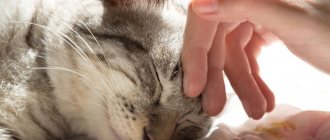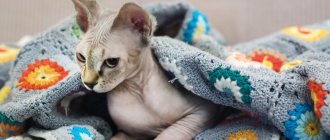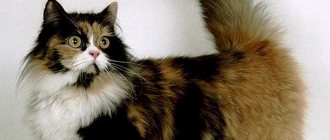Cats that knead blankets, bellies, or other furry things are common. But have you ever thought about it? For example, why do cats knead blankets with their paws? Or why do cats crumple in the first place?
Experts believe that kneading a cat always indicates something. It's like the feline is connecting to you through this behavior. A cat kneads its leg when it is very happy or misses its mother. There are many more likely reasons why a cat kneads soft blankets with its paws.
If you are interested, read this article. Learning more about your feline's behavior can help you care for it.
From a scientific point of view
"Milk step" is a term used in veterinary medicine to describe the behavior of a kitten when it receives milk from its mother. Kittens tend to massage the belly of a nursing cat, thereby stimulating milk production in the adult animal.
It is believed that when cats purr and move their paws, they fall into childhood. After all, the memory of one of the earliest and most pleasant events in an animal’s life remains in its subconscious forever. In addition, when stomping in one place, accompanied by purring, quiet smacking is often heard.
It is also known that animals separated from their mother early massage a soft blanket or blanket much more often than those who spent the required time with the cat.
A situation where a cat often moves its paws on its owner’s body means that he trusts him and feels comfortable in his presence. The animal does not feel fear, it is caressed, protected, well-fed and grateful. This behavior of the pet indicates that he is attached to the person as to his own mother.
What cats don't trample on humans?
If a cat moves its front paws, sometimes releasing its claws, in professional language this is called a “milk step”. The name refers to a certain fact about kittens: when babies “walk” on their mother's belly, they speed up the flow of milk to the nipples. This association lasts throughout life; kneading with paws is safe and healthy.
Lack of instinct is not due to breed, color or other general factor. Most often, this manifests itself in artificially raised kittens that have lost their mother and were fed from a pipette. It is a little less common for a mother cat to have a lot of milk. In both cases, the little pets did not need to crush the mother’s belly with their paws and get milk for themselves, so they do not show the characteristic instinct at a conscious age.
But this does not mean that the kitten will grow up “somehow different” or will love you less!
Kitten crumples a toy with its paws
Instinctive preparation of a place to rest
Before the domestication process began, cats made their own places to sleep. Often, in order to lie down comfortably, one had to crush the bristling grass with one’s paws. It was also important to make sure the bed was safe for future relaxation.
Cats are by nature cautious and selective - the predatory instincts of wild animals are alive in them and are not reduced. By pressing his owner's paws, the cat checks whether his body is safe enough to relax and fall asleep. With this action, cats may not purr, silently preparing a place for themselves to rest.
Comes from childhood
I know that I have had massage skills since birth. It was a long time ago, I don’t even remember my cat mother, but guess what, the “milk step” remains.
I don’t even notice how I switch to it if I feel soft under my paws. Apparently, the involuntary squeezing and unclenching of fingers was deeply ingrained in the child’s subconscious. After all, when you knead the warm, soft belly of a postpartum mother, you will get more milk, but it’s still delicious. You people will never understand this, you love chocolate more.
Selecting a territory
It is believed that the sweat glands on the paw pads of cats are involved in the process of identifying territory. The chemical composition of secretions in all living organisms, including humans, is unique to each individual. Animals can indeed communicate in this way what belongs to them. This is an instinctive process and it occurs spontaneously: a signal is recorded in the pet’s brain about the need to mark the territory. The favorite is reminded of this by the most ancient mental attitudes.
If a cat tramples a person with its paws, this means that the animal appreciates him and wants the owner to always be with him.
A little about cat physiology and the reasons for this behavior
Why does a cat lick a person: the main reasons and what it means
Cat massage attracts a lot of interest among pet owners. From a physiological point of view, there is a rational explanation why a pet tramples its beloved owner with its paws.
So, as mentioned earlier, stomping is a way of marking territory. The paws contain a large number of ducts and sweat glands that produce and secrete a special secretion. In addition, the paws of all types of cats are sensitive due to the large number of receptors and nerve endings. It is inherent in nature that animals receive a large flow of information about the world around them in this way.
The results of numerous scientific studies have also shown that during diligent pawing and trampling, the pets’ body begins to actively produce endorphin - the hormone of happiness, which allows you to relieve stress, calm down and, of course, relax.
Ancient Egyptian painting featuring cats
Stress relief
Cats often crumple a soft blanket or rug after they have been deprived or offended in some way. For example, they did not give a piece of sausage from the dinner table, although the animal begged for it with all its might. They woke you up or forced you to leave your favorite and already warm place. In this case, the pet often begins to intensively crush various interior items with its paws, however, it does not begin to purr.
Cats crush a person with their paws, splashing out negative emotions. The pet tries to improve his own mood. Often, after stomping around on the blanket for a while, the cat returns to its owner and lies down next to him - this is how the animal shows that it is no longer angry and is ready to continue friendly communication with the person.
Why does a cat suck its paw?
Experienced cat owners, volunteers and veterinarians with professional skills in caring for kittens believe, not without reason, that the habit of paw sucking mainly remains in individuals who were left too early without maternal care:
By doing this, the little ones compensate for the love of the mother cat, remembering how cozy it was next to her warm, furry tummy. Orphan kittens, when sucking their paw, feel safer, this calms them down. For an older cat, the habit does not go away; he also experiences a lack of parental attention and tries to make up for it with his manipulations. An analogy can be drawn with human children. If a kitten sucks its paw, then for the same purpose the child can twirl a strand of hair around his finger - first his mother’s, and later his own. Some people, even as adults, fidget with their earlobe if something bothers them. The paw is not the only thing a pet can “encroach” on. Many “under-caressed” cats, whenever possible, attach themselves to the hand or other part of the owner’s body.
It is very important for them to be close and feel a kindred spirit nearby. The animal may pick at a corner of a pillow, blanket, robe, or removed clothing, including worn socks. Perhaps the pet is attracted to the owner’s familiar aroma and taste
This is often accompanied by the release of claws.
Actually, these kitten habits look very cute. But if an adult cat is doing this, then the owner should be wary.
How to behave as an owner
While a cat is kneading the human body with its paws, the owner of the animal does not feel entirely comfortable due to the fact that he forgets himself and releases his claws. This, in turn, can bring a feeling of pain, both mild and quite strong.
Under no circumstances should you scold a cat, much less hit it. A loud, menacing voice or a harsh slap can cause misunderstanding and mistrust in a cat. She may begin to avoid the person and become aggressive towards him. Indeed, at the time when an animal tramples its paws on something, it experiences the most tender feelings.
However, you should not endure the pain from claws when in contact with a cat, nor should you turn a blind eye to the fact that the animal can ruin your interior items. The following actions will help minimize the negative consequences of paw trampling:
- Start gently stroking your pet’s paws; after a couple of minutes, the animal will remove its claws, continuing to stomp only on the pads;
- Start stroking your pet more intensively, and then gently lay it on its side;
- Distract your cat from what she is doing. Play with her or hug her.
Having considered the possible reasons why cats begin to knead a person’s body or interior items with their paws, we can see that in the vast majority of cases the animal does not do this because it experiences negative emotions. On the contrary, this is how the pet prepares for rest or shows a trusting attitude towards the owner.
Results
Cats are very sweet pets, whose presence in the house can bring real joy to their owner. You need to understand that sharpening its claws is a natural behavior of any cat, so you should not scold it for such actions. If you don’t like this cat’s “activity,” simply switch the cat’s attention to another object or toy. Treat your pet kindly, and he will definitely reciprocate you with love.
More from my site
- Cystitis in a cat treatment Treatment of cystitis in cats is an event that owners of these cute fluffies often face. After all, the problem is not so rare, and if you decide to get a pet, you need […]
- A cat yells at night - what to do How to stop a cat from yelling at night, since these sounds will certainly not allow you to live in peace. The well-being of its owner depends on the balance of the tail. This behavior can happen […]
- The cat began to mark - what to do At what age do cats begin to mark their territory, what to do and how to fix it. The situation becomes tense for all residents after being tagged due to the unpleasant odor. You shouldn’t immediately [...]
- Choosing food for your pet Many dog and cat people are accustomed to buying food for their pets in supermarkets or regular grocery stores located near their home. There you can find the most [...]
- Devon Rex cats Devon Rex is a cat that bestows “canine” devotion and a whole bouquet of pleasant emotions. At first glance, the Devon Rex is surprising: its strange appearance and increased friendliness; big ears and [...]
- Calcivirosis in cats, treatment and consequences Calcivirosis in cats is an acute infectious disease that is widespread among all cat breeds, especially affecting unvaccinated ones. The disease cannot pass to a person, but [...]
- How often can you wash a cat? How to wash a cat when most people don’t like to take baths. The question remains relevant even when the furry is a homebody and does not often walk outside. If you teach a cat to swim with [...]
- Oncilla - an unusual breed of cat The oncilla cat is a unique animal of the cat family, living in the vastness of Central and South America, Argentina, Brazil, Colombia and Costa Rica. Cats of this breed today [...]
- The Balinese cat is a graceful breed of cat. The Balinese cat was born at the beginning of the 20th century. The breed is a semi-long-haired cat with a non-standard color. Balinese or Balinese is very accessible in content, without […]
Treatment of hosts
Felinotherapy is a new direction in medicine. This technique can be tried by anyone who is not allergic to cats. The purr is able to feel that a person is in pain, he lies down on the sore spot and massages it with his paws.
And the purring of a cat can have a healing effect. Scientists have found that thanks to such magical sounds, bones thicken faster during fractures. It is known that the vibration frequency of sound waves emitted by cats ranges from 20 to 50 Hz, which helps bone tissue grow better.
Important! If you notice that a cat is crushing the bed with its paws, it is prohibited:
- Scold your pet and shout at it;
- Pushing, hitting and using physical force;
- Trim nails too short;
- Interrupt such manipulations during estrus.
Bottom line. Cat paw massage brings only benefits, relieves stress, pain and some diseases. And in general it brings only positive emotions.

